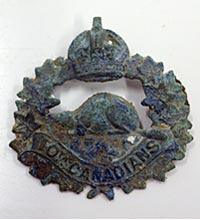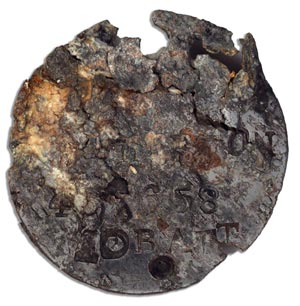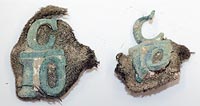


Among the possessions found with Pte Atherton’s skeletal remains was a 10th Battalion cap badge. Some of the artifacts included a brass Canada shoulder title, Canadian C10 numbered collar badge, plus his ID disc.
Shilo Stag
The Department of National Defence (DND) and the Canadian Armed Forces (CAF) have confirmed the identification of remains recovered during a munitions clearing process in Vendin-le-Vieil, France, as being those of Pte Harry Atherton, a Canadian soldier of the First World War.
The identity was confirmed through historical, genealogical, anthropological, archaeological and DNA analysis.
Pte Atherton was born in Leigh, England, on Nov. 15, 1893, and grew up in Tyldesley, England. He moved to Canada in 1913 by himself. He settled in McBride, British Columbia, and worked as a carpenter before enlisting in March 1916.
“The identification of Private Atherton gives the Canadian Armed Forces the opportunity to pay its respects and provide him with a final resting place. His courage and selfless service can never be fully repaid,” said Minister of National Defence Anita Anand.
“But Canada will remember and honour him, and those like him who gave so much for this country in the First World War. To his family I extend my sympathy and gratitude.”
Pte Atherton joined the Canadian Expeditionary Force (CEF) with the 63rd Canadian Infantry Battalion (Edmonton) at the age of 23. The following month, he left the port of Saint John, New Brunswick, bound for England.
After training, he arrived in France in July 1916, as a member of the 10th Canadian Infantry Battalion, and fought in several battles before being wounded and sent back to England to recover. He returned to the front in March 1917.
On Aug. 15, 1917, Pte Atherton fought with the 10th Battalion during the first day of the Battle of Hill 70 near Lens, France. He was reported as wounded that day but later reports stated that he had been killed in action at age 24.
The Battle of Hill 70 continued until Aug. 25, 1917, with a heavy toll of more than 10,000 Canadians killed, wounded or missing. The 10th Battalion suffered 429 casualties, 71 with no known grave.
The CAF has notified the family of Pte Atherton’s identification and is providing them with ongoing support. He will be buried at the earliest opportunity in the Commonwealth War Graves Commission’s Loos British Cemetery in Loos-en-Gohelle, France.
The Canadian Armed Forces’ Casualty Identification Program, within the Directorate of History and Heritage, identifies unknown Canadian service members when their remains are recovered.
The program also identifies service members previously buried as unknown soldiers when there is sufficient evidence to confirm the identification.
“Though it has been more than a century since we lost Pte Atherton in the Battle of Hill 70 during the First World War, I’m proud that we were able to identify his remains and provide him with a proper burial. His contributions to Canada will never be forgotten. Lest we forget,” offered Minister of Veterans Affairs and Associate Minister of National Defence Lawrence MacAulay.
Quick Facts
• Pte Harry Atherton was born in England in 1893, the son of the late James Henry Atherton and Sarah Atherton (née Bradbury) of 87 Manchester Rd., Leigh, Lancs, England. His service number was 467658.
• He is commemorated on the Canadian National Vimy Memorial, erected in memory of Canadian soldiers killed in France during the First World War who have no known grave.
• On July 11, 2017, human remains were recovered during a munitions clearing process north of Lens, France. Commonwealth War Graves Commission staff recovered the remains and several artifacts, including an identification disc and insignias of the 10th Bn. He was with A Coy as part of the Alberta Regiment.
• Through historical, genealogical, anthropological, archaeological, and DNA analysis, with the assistance of the Canadian Forces Forensic Odontology Response Team, and the Canadian Museum of History, the Casualty Identification Review Board was able to confirm the identity of the remains as those of Pte Harry Atherton in October 2021.
• Veterans Affairs Canada works with the Casualty Identification Program to identify next of kin and supports the participation of the two closest next of kin in the burial ceremony overseas.
• The Commonwealth War Graves Commission commemorates the 1.7-million Commonwealth servicemen and women who died during the two world wars. Using an extensive archive, the Commission works with their partners to recover, investigate, and identify those with no known grave to give them the dignity of burial and the commemoration they deserve.

